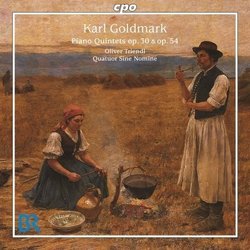| All Artists: Karl Goldmark, Oliver Triendl Title: Karl Goldmark: Piano Quintets Op. 30 & Op. 54 Members Wishing: 0 Total Copies: 0 Label: Cpo Records Release Date: 9/30/2008 Genre: Classical Styles: Chamber Music, Historical Periods, Classical (c.1770-1830) Number of Discs: 1 SwapaCD Credits: 1 UPC: 761203727728 |
Search - Karl Goldmark, Oliver Triendl :: Karl Goldmark: Piano Quintets Op. 30 & Op. 54
 | Karl Goldmark, Oliver Triendl Karl Goldmark: Piano Quintets Op. 30 & Op. 54 Genre: Classical |
Larger Image |
CD DetailsSimilar CDs
|
CD ReviewsTwo Very Engaging Piano Quintets by an Almost Forgotten Mast J Scott Morrison | Middlebury VT, USA | 10/03/2008 (5 out of 5 stars) "Karl Goldmark (originally named Károly Goldmark; 1830-1915) comes very close to being a one-hit wonder, although he was celebrated in his day. He has two or three works that remain on the edge of repertory status: his Violin Concerto Itzhak Perlman - Goldmark & Korngold: Violin Concertos / Previn, the Symphony, 'Ländliche Hochzeit' ('Rustic Wedding') Goldmark: Rustic Wedding Symphony, and his opera 'Die Königin von Saba' ('The Queen of Sheba') with its famous tenor aria 'Magische Töne' ('Magical Tones') Goldmark: Die Königin von Saba (this latter is really a superb recording but costs an arm and a leg, I'm afraid). He was born in Hungary, sent by his father, a Jewish cantor, to study in Vienna where the money quickly ran out. He is thus more or less self-taught and was influenced both by Brahms, who befriended him, and Wagner, whose anti-semitism prevented any close friendship even though Goldmark had helped found the Viennese Wagner Society.
The two piano quintets are new to me, as I suspect they are to most music-lovers, and a real discovery. Formally they remind one of Brahms, or perhaps Schumann, but harmonically they are highly chromatic, clearly influenced by Wagner, most obviously so in the later of the two quintets. The two are separated by thirty-five years or so, the first being written in 1879, the second toward the end of the composer's life when he was in his eighties. Both are in the usual four movements and tend to emphasize the pianist's contribution, although in the Adagios there is some luscious, deeply felt string writing. The Piano Quintet No. 1 in B Flat, Op. 30, opens with what seems to be a simple-minded folk tune which quickly is put through unexpected Wagnerian harmonic twists with some Brahmsian metrical displacements, signaling that, in that time of sharp divisions between the adherents of those two composers, we are in the presence of composer who is his own man. There is considerable contrapuntal complexity albeit delicacy about halfway through this first movement; it reminds me of similar things one hears in late Beethoven. The Adagio is utterly lovely and deeply felt. It contains cantabile writing for the cello that is gorgeously played by the Quatuor Sine Nomine's Marc Jaermann. The Scherzo is a burbling, healthily optimistic movement with some echoes, especially in the piano writing, of Schubert's 'Trout'. The Finale, marked Allegro vivace, is a rondo whose A section is just short of trite. It goes on for almost nine minutes, almost as if Goldmark couldn't quite figure out how to end it. Still, it has some silvery piano filigree and a good deal of rhythmic vitality. The Piano Quintet No. 2 in C Sharp Minor, Op. 54 is an altogether more dramatic work, highly chromatic -- it opens in C Major and quickly modulates to the distant C Sharp Minor! -- and almost modern-sounding work. It is important to remember that it was written after Impressionism and Sacre du Printemps had burst on the scene. Although it does not partake particularly of those two musical trends, it is nonetheless harmonically much more complex and sophisticated than its junior partner. The work is more tightly structured than the first quintet in that it is cyclical, with primary themes from all four movements showing up throughout the entire work. After the restless, almost anguished, first movement, the Adagio comes as both a resting spot and a soul-searching exploration. There is a lyrical section that I found myself returning to again and again, one that has the piano playing chorale-like chords interspersed with ethereal muted strings. The Scherzo has a slow, almost Haydnesque, introduction followed by a tangy allegro full of high spirits. The Finale, Moderato assai, the most chromatic movement of all, is, after a lyrical introduction, both violent and ultimately triumphant. It is played with a vigor and, dare I say it, almost Gypsy abandon that has been absent in the preceding movements. I found myself really falling in love with this quintet and I'd estimate I've listened to it perhaps ten times now. Pianist Oliver Triendl has made a real name for himself in a series of releases on the adventurous cpo label, e.g., Ludwig Thuille: Piano Quintets, Paul Juon: Piano Quartets, Opp. 37 & 50, Kiel: Complete Piano Quartets, and I find that I am getting just about everything he records. A consummate chamber music pianist. The Quatuor Sine Nomine are less well-known to me, but I find their playing on this CD to be subtle, in exquisite control and quite musical. I recommend this disc without reservation. Scott Morrison" |


![Melchior Schildt, Peter Morhard: Complete Organ Works [Hybrid SACD]](https://nationalbookswap.com/cd//m/02/6602/6176602.jpg)